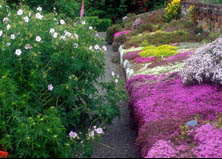Colourful AGM chives, marjorams and Joe Pye Weed
 Cutting back herbs half way through the season is a great way of having a second (or third) crop of fresh leaves to harvest as well as sometimes producing more flowers. The multicoloured rows in the chive bed were cut down over a month ago and are now looking colourful again. In the picture you can see ordinary chives Allium schoenoprasum at the back, with the rich pink of 'Pink Perfection' and the bright, large heads of 'Black Isle Blush' in the foreground. Both these excellent varieties originated at Poyntsfield on the Black Isle & received an Award of Garden Merit from the RHS. They look so attractive that they can be grown at the front of a flower border or used in combination with low grasses or silvery plants such as lambs ears.
Cutting back herbs half way through the season is a great way of having a second (or third) crop of fresh leaves to harvest as well as sometimes producing more flowers. The multicoloured rows in the chive bed were cut down over a month ago and are now looking colourful again. In the picture you can see ordinary chives Allium schoenoprasum at the back, with the rich pink of 'Pink Perfection' and the bright, large heads of 'Black Isle Blush' in the foreground. Both these excellent varieties originated at Poyntsfield on the Black Isle & received an Award of Garden Merit from the RHS. They look so attractive that they can be grown at the front of a flower border or used in combination with low grasses or silvery plants such as lambs ears.
The marjorams are in full flower right now, the plants in the National Collection grown in defined clumps for propagating and identification with a separate area where they are allowed to run riot and self seed in a very natural Mediterranean hillside kind of way.
A plant from a very different kind of terrain, Joe Pye Weed looks rather spectacular in late August and September. Growing wild in damp meadows (on the same sort of land as does our native meadowsweet) this gorgeous tall perennial is way above my head this year, revelling as it has done in the wet summer. Last year, it was a good three feet shorter! Nice to know something has done well out of all the rain. It's a plant that does fine in flower arrangements and lasts ok - I've just given some to one of our volunteers who has the month of August to do the flowers in a local church. Also good for attracting insects, this plant usually has masses of hover flies, bees and butterflies around it but butterflies seem to have been really badly hit by the weather and we've seen alarmingly few - even though the long buddleia hedges are full out. There's lots of late summer flowers out in the walled garden and at least there are plenty of bumble bees.



